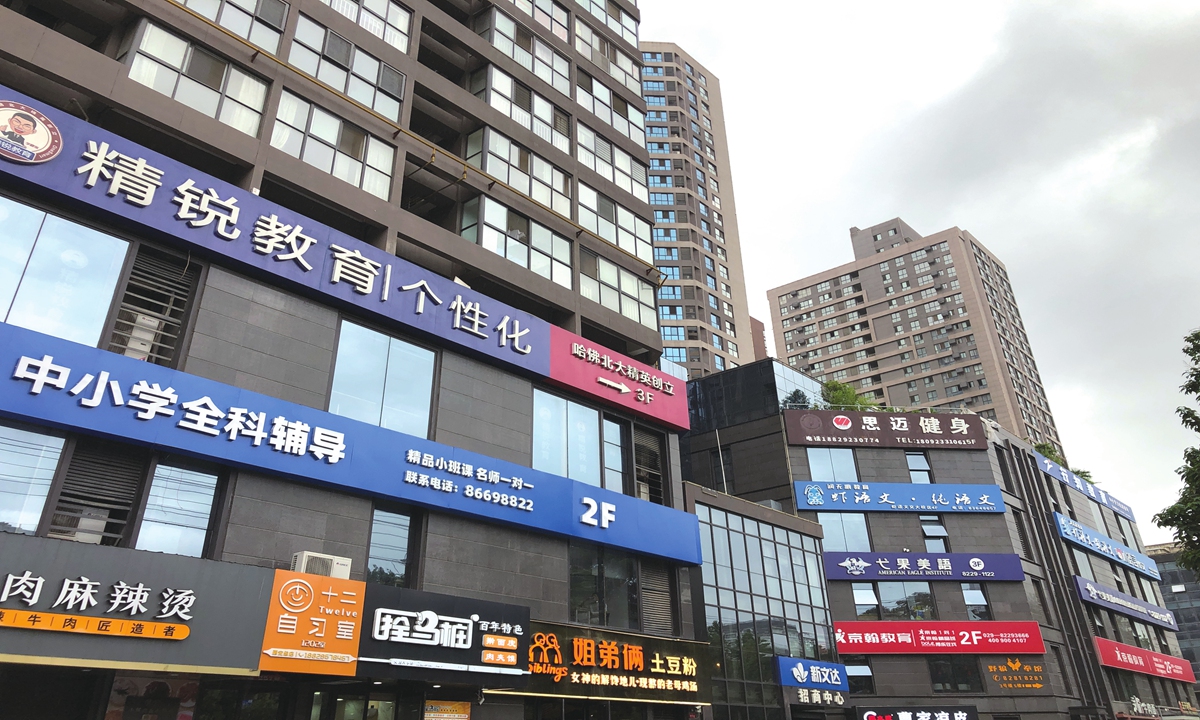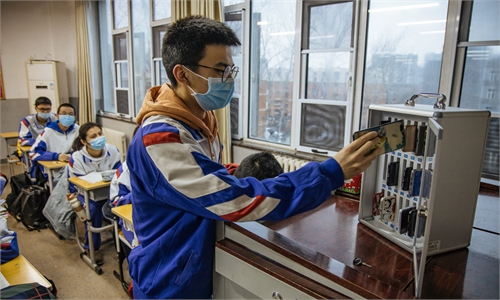China’s curriculum-based private tutoring pricing down
Excessive profit-seeking curbed, equality returning

A photo taken on July 26, 2021 shows multiple after-school tutoring institutions locate on the same street in Xi'an, Shaanxi Province. Photo: VCG
As local governments gradually set in place price caps for after-school curriculum-based tutoring by the end of 2021, China's efforts to overhaul the private education sector by implementing the "double reduction" policy, the excessive profit-seeking behavior of out-of-school tutoring institutions has been effectively curbed, making education accessible again.
Among the guiding prices announced by some provinces and municipalities so far, the maximum after-school training for offline courses is 80 yuan per class hour per student ($12.5), with the minimum is less than 10 yuan, most classes are between 20 and 50 yuan, according to a report by the Xinhua News Agency.
Compared with offline classes, the difference in the guiding price for their online equivalent is relatively small, with most being between 15 to 20 yuan per class hour per student.
China in September said local governments should set the fees for after-school tutoring institutions that offer compulsory education subjects. Local governments should establish benchmark fees and floating ranges, and include them in pricing catalogs, according to a notice from the National Development and Reform Commission, the country's top economic planner. Price increases from the standard level will be capped at 10 percent.
Pricing standards are mostly divided into multiple grades according to different administrative regions and class types. As stipulated by first-tier cities like Beijing and Shanghai, offline classes with less than 10 students are 80 yuan per class hour per person, classes with 10 to 35 students are 60 yuan per class hour per person, and if above 35 students, the price is at 40 yuan.
In North China's Shanxi Province, the after-school training fees per person per class hour range from 9 to 28 yuan.
The price-cap policy for after-school training in various localities has taken several months from inception to its introduction. The overall principle is based on the premise of adhering to the non-profit nature of after-school tutoring for compulsory subjects. Meanwhile, such factors as the level of local economic development and the affordability of students' families are taken into consideration, according to the Xinhua report.
A Beijing-based former course research and develop staff of private tutoring agency VIPKID, surnamed Zhao, told the Global Times on Sunday that prior to the price-cap policy, average pricing for per class hour per student ranged from 100 to 200 yuan. With parents usually paying thousands or even tens of thousands of yuan up front.
"The reduction of class fees will definitely affect the income of teachers. The income of some teachers with high grades or teachers that teach difficult courses will drop significantly. This is why I have not continued to look for a job in the education and training sector," Zhao said.
Parents' concerns
Price-cap policies as implemented in China's localities will effectively curb the excessive profit-seeking behaviors of private tutoring agencies, making the education sector more sustainable, industry observers said. While it also promotes the reshaping of the industry to develop on a healthier track.
Lu, who is in charge of a subject training institution in Yancheng, East China's Jiangsu Province said her fees are lower than the government's guiding prices, set at less than 20 yuan per class hour per student on average.
"Now as the competitiveness in the private tutoring sector has dwindled following the nation's overhaul, there is still room for survival," Lu noted.
As tutoring prices fell, some parents started to become worried that the expensive one-on-one tutoring will rise. According to industry insiders, after the "double reduction" policy, some after-school tutoring institutions cancelled their larger class tuition, and instead pivoted to high-end one-on-one tutoring.
The "double reduction" policy refers to a reduction in homework and in time spent in extra-curricular classes or after-school private tutoring. The range of measures aims to promote equality in the education sector by extending on-campus classes for every student.
A Beijing-based white-collar worker surnamed Xiong, whose child is now attending online mathematic class for 140 yuan per hour, said she is a little worried that outstanding teachers will raise their fees for one-on-one tutoring.
"I don't think the charging fees in cities like Beijing and Shanghai will be slashed significantly because institutions also face high house rental costs," she told the Global Times.
"According to the parents I have contacted, they prefer to hire one-on-one or one-on-two tutors for their children, but from the perspective of economic conditions, large group classes with low training courses are also an option," Zhao said.
China's tightened scrutiny on the curriculum-based private tutoring has made significant progress with more than 80 percent of online and offline private tutoring institutions now closed, data from the Ministry of Education (MOE) revealed in December.
Offline training institutions have been reduced by 83.8 percent, while the online groups have been cut by 84.1 percent.
Some of the remaining training institutions have been repurposed as non-profit institutions, implementing government-guiding prices and providing public welfare services, while those that are not suitable for non-profit operations will be further written off, said the MOE.
Since the implementation of the "double reduction" policy, schools across the country have formulated relatively complete homework management methods and established a homework awareness system. The proportion of students completing homework within prescribed time has increased to more than 90 percent on current rates, from 46 percent prior to the implementation of the policy, according to the MOE.

